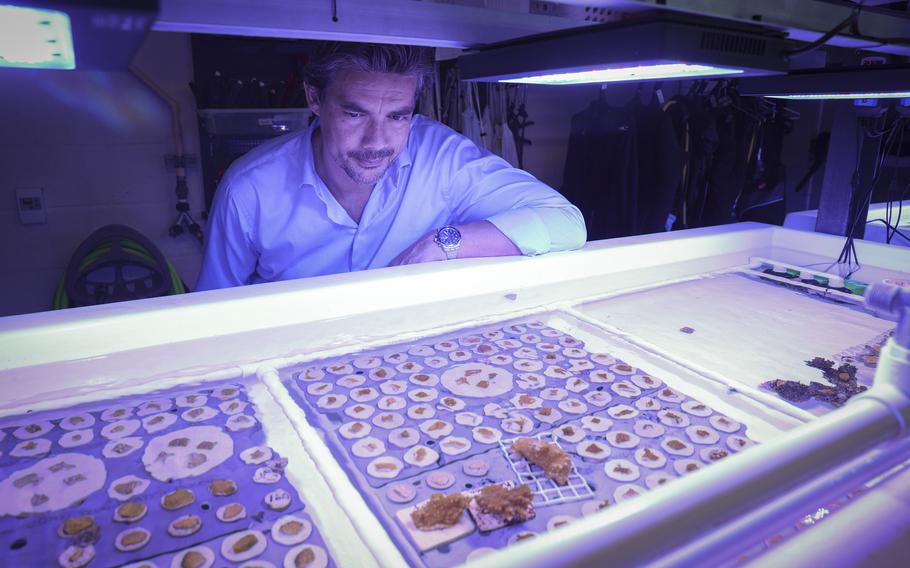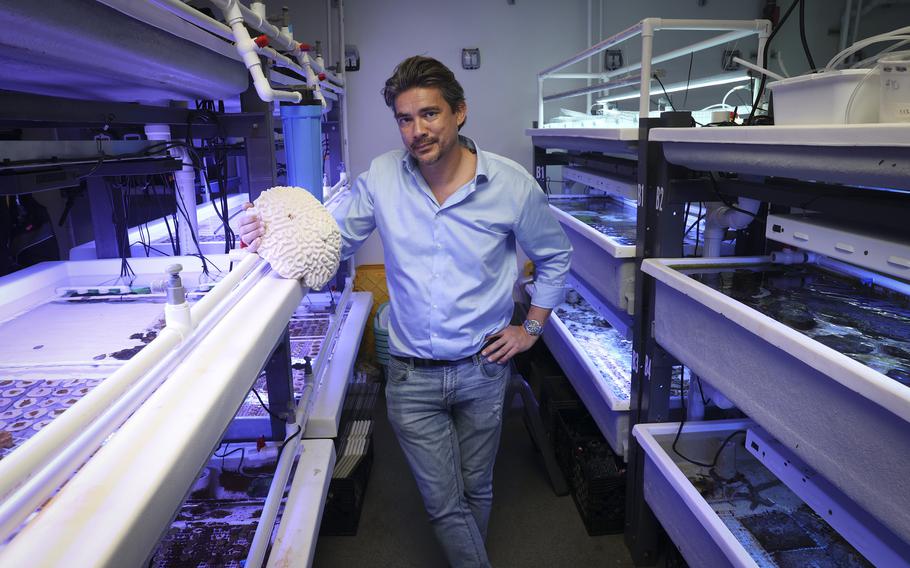
University of Miami professor Andrew Baker poses in a wet lab while looking at corals on Thursday, Dec. 15, 2022, in Miami at the Rosenstiel School of Marine, Atmospheric, and Earth Science. Baker is working on a military-funded research project to develop “hybrid reefs”. The X-Reefs are composed of natural, living corals growing on a man-made structure that’s engineered to slow down waves. (Alie Skowronski, Miami Herald/TNS)
MIAMI (Tribune News Service) — The nation’s military has been working on a new weapon: Creating a “perfect,” self-healing coral reef that can withstand disease, warming temperatures and sea rise.
Many U.S. military bases along the coasts are feeling the effects of climate change, and their current methods of defense — like sea walls — aren’t working against flooding and erosion. A reef would break up waves before they crash against the base.
So for the past 14 months, the Department of Defense has been working with three international teams of scientists, including from the University of Miami, to build a hybrid reef made of concrete and coral.
If it works, it may be a solution for cities and regions that face the worst effects of climate change, such as Miami. And the military appears to think it’s worth banking on.
The project is expected to receive its next, second infusion of grant funding, on top of the $7.5 million it’s already received. By the end of the project, the team could receive more than $20 million.
It’s also a race against time, after higher-than-normal temperatures caused widespread bleaching of thousands of corals in the Florida Keys.
The Defense Advanced Research Projects Agency, or DARPA, selected UM to lead the Atlantic coral project. Rutgers University in New Jersey is focusing on oysters on the Gulf Coast; and the University of Hawaii is using coral from the Pacific Ocean.
The UM-led project, called X REEFS, was given 5 years to take the concept from design to production and cost evaluation.
UM’s team is made up of 12 organizations that in ordinary circumstances would not cross academic paths. Coral biologists are working with aerospace engineers, manufacturers and hydrologists to make the hybrid reef a reality.
“We essentially examined, is it going to cost more in the long run to adapt to climate change,” said Laura Cherney, program manager from AECOM. “And we found it’s not. And to adapt now, because there is saving.”
How it’s going to work
Compared to other artificial reef projects that are typically offshore and intended for fishing or deep water dives, the hybrid reef needs to be close to shore and must stay submerged at 12 feet, the lowest tide.
The reef design is made up of three stacked layers. The bottom layer is a concrete chamber called the “sea hive” after its honeycomb shape. As waves hit the bottom row of sea hives, turbulence is reduced from underneath.
“We are trying everything we can do to move the water over, under and through,” said Borja G. Reguero, a researcher at the University of California-Santa Cruz.
The middle layer consists of concrete lattices that are gyroid-shaped. If the term gyroid doesn’t ring a bell from geometry class, think of a shape that’s infinitely connected with no straight lines and plenty of holes, like the inside of a bone or a butterfly wing. It’s one reason the team picked the gyroid shape: It already occurs in nature.

University of Miami professor Andrew Baker poses in a wet lab with a coral on Thursday, Dec. 15, 2022, in Miami at the Rosenstiel School of Marine, Atmospheric, and Earth Science. (Alie Skowronski, Miami Herald/TNS)
“Nobody else has done this, created these large concrete gyroid shapes, we’re definitely forging a path here,” said Michael Yukish, a Penn State aerospace engineering professor.
The top layer features “coral mimics” — squishy and fragile foam that is coated with an epoxy and fiberglass to give it strength. Within that structure, living coral fragments will be seeded. As the sea rises, the coral should slowly grow, too, building its own skeleton around the concrete.
“I mean the idea is if 100 years from now, a ship runs into it, they’d say, ‘Oh my gosh. There’s concrete inside it.’ It should be a hidden fact that we created the scaffolding first,” Yukish said.
Breeding resistant coral
The Rosenstiel School of Marine, Atmospheric and Earth Science at UM is considered the “Noah’s Ark” for the coral that’s being used in the hybrid reef project.
There, the coral is housed in large tanks where temperatures can be measured to the decimal point. The team makes sure the corals are well-fed, implanted with the correct algae and given plenty of light and a lot of water flow.
“The last four years have been the growing pains of getting this built, working out the kinks and incrementally making improvements along the way to make things better and better,” said Andrew Baker, the UM professor leading the team on the project. “We’ve finally met that pipeline stage.”
The Florida Aquarium also is helping the UM team breed coral. They’re looking for the “hardiest coral” that grows quickly but can withstand stressors like temperature.
If they find the 100 ‘best’ coral, then they can breed those species into thousands, kind of like tomato plants being modified over generations for taste and color.
In a year, the Florida Aquarium tripled the amount of coral spawned in a tank.
“It just gives us hope that OK, some of these babies might be the one. They might be the deep tolerance we are looking for,” said Keri O’Neil, with the Florida Aquarium.
Military test
The X-REEFS team is waiting for results from the military’s first milestone test, proving the reef reduces wave “energy” by at least 70 percent. The calculation is complicated, but they’re measuring wave height and velocity to get the results. The team is optimistic because they tested their reef in UM’s wind-wave tank that can create Category 5 hurricane force winds of up to 155 mph, and it met the requirement.
“If you think of a wave that breaks, like if you’re going to the beach it can knock you over,” said Catherine Campbell, the DARPA project manager. “But if you take all the energy out of the wave, it’s lapping at your feet.”
The second phase is moving out of the lab and onto collecting data about how the reef performs in the ocean. The team met in Miami last month to visit the possible sample test site, which is less than a half mile off of Elliot Key at Biscayne National Park.
U.S. military installations have experienced more than $10 billion in damage from storms and flooding over the past five years, and more than 1,700 posts may be affected by sea level rise.
“We’ve already seen this damage, we see the erosion every day,” Campbell said. “We’ve seen a lot of good successes in the laboratory that show us it’s possible to selectively breed coral, to be more thermally tolerant, to be more resistant to disease.”
“We’re trying to push science forward,” she said.
Ashley Miznazi is a climate change reporter for the Miami Herald funded by the Lynn and Louis Wolfson II Family Foundation in partnership with Journalism Funding Partners.
©2023 Miami Herald.
Visit at miamiherald.com.
Distributed by Tribune Content Agency, LLC.